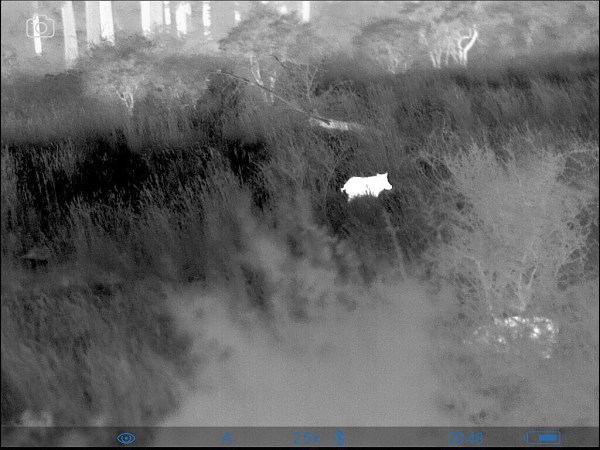
At closer distances, F-o-M is far more important. If using a thermal for bush stalking and hunting in wooded areas, the target may only be 50 to 150 metres away. A wide F-o-M means that the target can be picked-up quickly.
Magification and F-o-M is mainly determined by the following factors:
• Lense focal lengthLonger focal length lenses provide a higher magnification for any given sensor size. Shorter focal length lenses provide a wider F-o-M.
A long focal length is usually around 50mm, while a shorter focal length is around 30mm.
Thermals that are to be used in a variety of terrains tend to have lenses around 40mm.
• Sensor size- the physical size of the sensor plays a big part in determining magnification and F-o-M.
A smaller sensor will have a higher magnification and narrower F-o-M for any given lens focal length. For instance, a 384×288 sensor with a 17µ pitch will have a higher magnification and narrower F-o-M than a 640×480 sensor with a 17µ sensor.
It must be stressed that I am referring to the physical size of the sensor, not the number of pixels and pixel size. For instance, sensors with a 12µ pixel size will have a smaller physical size than comparative 17µ sensor. An example is that a 640×480/12µ sensor has a similar physical size as a 384×288/17µ sensor. Sensors with 12µ pixels use shorter focal length lenses to achieve the desired magnification and F-o-M.
Sensor type
Most thermals available in New Zealand do not provide a testing standard for the sensor, which may lead to the use of sensors that may not be designed for the knocks and shocks of riflescopes and handhelds. For instance, sensors with 640×512 pixels are commonly found in fixed camera security systems, whereby the image is displayed on a computer monitor. When a 640×512 sensor is used with a 4:3 micro display, such as 1024×768, the image is cropped to 640×480. Do not be misled into believing that a 640×512 pixel sensor offers any advantage.
Pulsar thermal imagers use French made Lynred sensors that are used for defence, aeronautics and other highend uses. These sensors are milspec to MIL-STD-810 and MIL-STD-883 standards, ensuring that the sensor will deliver high performance and lower failure rate in harsh conditions. This is one of the reasons that Pulsar thermals are the first choice for professional and government users.
Other considerations
The power supply is very important for getting the most out of your thermal. Factory designed batteries that deliver the correct current and can be replaced in an instant is the best option.
A metal body with an inbuilt heat sink will protect the thermal from internal heat build-up that may reduce its performance and working life. Also make sure it is fully waterproof (IPX7).
The best displays are AMOLED. LCD and LCOS are old technology and only found in cheaply made thermals.
At the end of the day, you pays your money and takes your choice. Do your research and don’t be mislead.
Coastguard New Zealand Conference 2022
The recent Coastguard New Zealand Conference was again a huge success. Advanced Optics sponsored day 2 and day 3 of the event, as well as the Air Patrol Special Merit Award. Advanced Optics also donated by way of raffle, a Pulsar Lexion XP38 thermal imager and a set of ANV Generation 3 night vision goggles.
Visit the Coastguard New Zealand website for more information and please make a donation to this fine organisation: coastguard.nz













